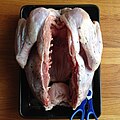Butterflying
Butterflying is a culinary technique used to prepare meat, poultry, fish, and shellfish for cooking. The method involves splitting the food item almost in two, but leaving it attached at one edge, then spreading the two halves open to resemble a butterfly's wings. This technique is not only applied for aesthetic purposes but also has practical applications in cooking, such as ensuring even cooking, reducing cooking time, and allowing for more surface area to apply seasonings or stuffings.
Process
The process of butterflying can vary slightly depending on the type of food being prepared. Generally, it involves the following steps:
- For meat and poultry, the item is placed on a cutting board, and a sharp knife is used to slice it horizontally, stopping just short of cutting all the way through.
- For fish, the backbone is often removed as part of the butterflying process, which may require a slightly different technique and tools, such as kitchen shears.
- For shellfish, such as shrimp, the process involves cutting along the back of the shell to remove the vein and then flattening the shellfish out.
Benefits
Butterflying has several benefits in culinary applications:
- Even Cooking: Flattening the food item allows it to cook more evenly, reducing the risk of undercooked or overcooked sections.
- Reduced Cooking Time: By increasing the surface area of the food, butterflying can significantly reduce cooking time, which is particularly beneficial for thick cuts of meat or whole poultry.
- Increased Flavor: The larger surface area exposed by butterflying allows for more seasoning or marinade to be applied directly to the meat, enhancing flavor.
- Stuffing: Butterflied meats can be easily stuffed with various fillings, adding complexity and variety to dishes.
Applications
Butterflying is used in a variety of dishes across different cuisines:
- In barbecue, butterflied lamb or chicken is a popular choice, allowing for quicker cooking times and more surface area for rubs and sauces.
- Stuffed meats, such as a butterflied pork loin filled with herbs, garlic, and breadcrumbs, showcase the technique's ability to enhance flavor and presentation.
- Butterflied shrimp are often used in grilling or broiling, allowing for a more even exposure to heat and making it easier to add seasonings.
Tools
The primary tool needed for butterflying is a sharp knife, preferably a chef's knife or a boning knife, which allows for precise cuts. Kitchen shears may also be used, especially for fish and shellfish.
Conclusion
Butterflying is a versatile and useful technique in the culinary world, offering both practical and aesthetic benefits. By understanding and mastering this technique, cooks can improve the quality of their dishes, enhance flavors, and reduce cooking times.
Transform your life with W8MD's budget GLP-1 injections from $125.
W8MD offers a medical weight loss program to lose weight in Philadelphia. Our physician-supervised medical weight loss provides:
- Most insurances accepted or discounted self-pay rates. We will obtain insurance prior authorizations if needed.
- Generic GLP1 weight loss injections from $125 for the starting dose.
- Also offer prescription weight loss medications including Phentermine, Qsymia, Diethylpropion, Contrave etc.
NYC weight loss doctor appointments
Start your NYC weight loss journey today at our NYC medical weight loss and Philadelphia medical weight loss clinics.
- Call 718-946-5500 to lose weight in NYC or for medical weight loss in Philadelphia 215-676-2334.
- Tags:NYC medical weight loss, Philadelphia lose weight Zepbound NYC, Budget GLP1 weight loss injections, Wegovy Philadelphia, Wegovy NYC, Philadelphia medical weight loss, Brookly weight loss and Wegovy NYC
|
WikiMD's Wellness Encyclopedia |
| Let Food Be Thy Medicine Medicine Thy Food - Hippocrates |
Medical Disclaimer: WikiMD is not a substitute for professional medical advice. The information on WikiMD is provided as an information resource only, may be incorrect, outdated or misleading, and is not to be used or relied on for any diagnostic or treatment purposes. Please consult your health care provider before making any healthcare decisions or for guidance about a specific medical condition. WikiMD expressly disclaims responsibility, and shall have no liability, for any damages, loss, injury, or liability whatsoever suffered as a result of your reliance on the information contained in this site. By visiting this site you agree to the foregoing terms and conditions, which may from time to time be changed or supplemented by WikiMD. If you do not agree to the foregoing terms and conditions, you should not enter or use this site. See full disclaimer.
Credits:Most images are courtesy of Wikimedia commons, and templates, categories Wikipedia, licensed under CC BY SA or similar.
Contributors: Prab R. Tumpati, MD



